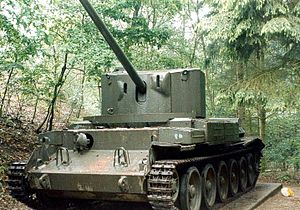Cruiser Mk VIII Challenger
| Tank, Cruiser, Challenger (A30) | |
|---|---|
 One of the two last surviving Challengers, preserved at the Overloon War Museum. The other survivor is awaiting restoration at the Isle of Wight Military Museum. | |
| Type | Cruiser tank |
| Place of origin | |
| Production history | |
| Designer | Birmingham Carriage & Wagon Company |
| Number built | 200 |
| Specifications | |
| Weight | 33 tonnes (32 LT; 36 ST) |
| Length | 8.147 m (26 ft 9 in) |
| Width | 2.90 m (9 ft 6 in) |
| Height | 2.775 m (9 ft 1 in) |
| Crew | 5 (Commander, gunner, loader, co-loader, driver) |
| | |
| Armour | 20–102 mm (0.79–4.0 in) |
| Primary armament | QF17 pdr, 42 rounds |
| Secondary armament | 7.92 mm Besa machine gun |
| Engine | Rolls-Royce Meteor 600 hp (450 kW) |
| Suspension | Christie suspension 6 road wheels |
| Operational range | 193 km (120 mi) |
| Speed | 32 mph, 52 km/h |
The Tank, Cruiser, Challenger (A30) was a British tank of World War 2. It mounted the 17 Pounder gun on the Cromwell chassis to add heavier anti-tank firepower to the cruiser tank units.
History
The driving force in the development of Challenger was . Robotham had been a Rolls-Royce executive in the car division who, with no work to do, had led a team to develop a tank powerplant from the Rolls-Royce Merlin aircraft engine. The Rolls-Royce Meteor gave the British a powerful reliable engine which would power the A27M Cromwell tank. Robothams contributions gained him a place in the Ministry of Supply and on the Tank Board despite his lack of experience in tank design.
Initially Vickers had been working on a "High Velocity" 75 mm (3.0 in) gun to be fitted to Cromwell but it was realised that the Cromwell's turret ring was too small to mount it. There were longer term plans to develop improved tanks to replace Cromwell - this would deliver the interim Comet tank and, at the end of the war, the Centurion tank.
The General Staff brought forward a specification A29 for a 17 pounder armed cruiser tank. This was passed over for the alternate specification A30 for a 17 pounder armed tank.
In 1942, an order for a 17 pounder gun armed tank was placed with Birmingham Carriage expecting it to be based on the A27M components. Turret and gun mounting was in the hands of Stothert & Pitt. Birmingham Carriage had to modify the Cromwell hull to take a bigger turret.
Design
To accommodate the large weapon and a second loader, a turret larger than that of the Cromwell was required and the hull had to be enlarged. It was lengthened and an extra road wheel added. This change in length without a corresponding change in width across the tracks reduced mobility compared to the Cromwell. The hull machine gun was removed for stowage of the long 17pdr cartridges. It was expected that these large and heavy 17 pdr ammunition together with its stowage forward would require two loaders and this led to a larger turret. In order to keep the weight under control, compromises had to be made and armouring was reduced. It was not possible to reduce hull armour so it was reduced on the turret 63 mm on the front and 40 mm on the side compared to 75 mm and 60 mm on the Cromwell. The base of the turret was unprotected so to clear any jam resulting from enemy action a jacking feature was fitted.
The first Challenger was completed in 1942, the second tested at Lulworth. At that time the Challenger was criticized that although it would be effective at long range against the current best gunned tank in German service, the Panzer IV "Special" with the long 75 mm gun at shorter ranges it would be at a disadvantage due to slow firing rate and thin armour. An order for 200 was placed in February 1943. In November of that year it was announced that no more would be ordered.
Service
Unfortunately, due to some short sightedness no provision had been made for deep wading trunking and the A30 was unable to participate in the Normandy landings, the tank having to wait until ports had been secured and the Mulberry harbours completed. The Challenger, despite its high centre of gravity was liked by its crews as it was somewhat faster and more agile than the equivalently armed Sherman Firefly. The Firefly design which had been a backup proved to be easier to build and production of the Challenger was stopped with about 200 built. Many of the A30s were issued to units using the Cromwell to ease maintenance as they shared many parts.
Variants
The Avenger or SP 17pdr, A30 (Avenger) was a variant on the Challenger idea with a differently shaped open topped turret to help reduce weight. With priority production at Vauxhall Motors for the Comet tank, those built in 1945 were not ready for use until after the end of the war in Europe. Some 250 were built and these formed part of the BAOR in Germany.
Notes
References
- (1993). The Universal Tank. HMSO. ISBN 0-11-290534-X.